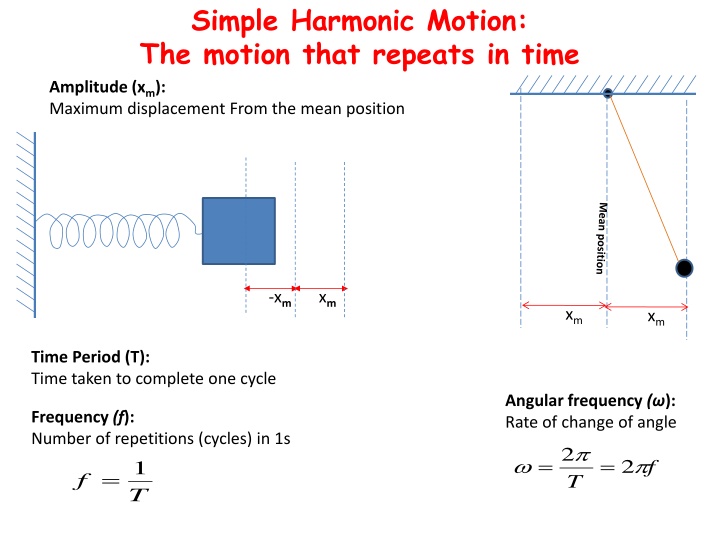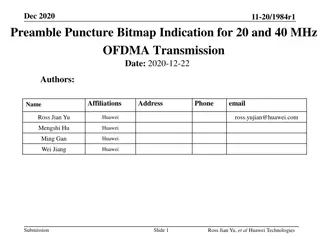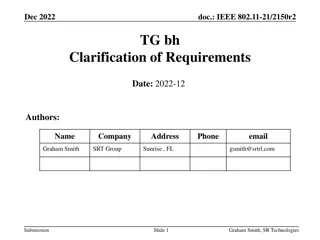
Simple Harmonic Motion Equations and Characteristics
Explore the principles and equations of simple harmonic motion, such as displacement, velocity, acceleration, and phase constant. Learn about key parameters like period, frequency, and amplitude, and delve into practical examples to deepen your understanding.
Download Presentation

Please find below an Image/Link to download the presentation.
The content on the website is provided AS IS for your information and personal use only. It may not be sold, licensed, or shared on other websites without obtaining consent from the author. If you encounter any issues during the download, it is possible that the publisher has removed the file from their server.
You are allowed to download the files provided on this website for personal or commercial use, subject to the condition that they are used lawfully. All files are the property of their respective owners.
The content on the website is provided AS IS for your information and personal use only. It may not be sold, licensed, or shared on other websites without obtaining consent from the author.
E N D
Presentation Transcript
Simple Harmonic Motion: The motion that repeats in time Amplitude (xm): Maximum displacement From the mean position -xm xm xm xm Time Period (T): Time taken to complete one cycle Angular frequency ( ): Rate of change of angle Frequency (f): Number of repetitions (cycles) in 1s 1 = 2 = = 2 f f T T
Simple Harmonic Motion The displacement (x) of the particle which executes simple harmonic motion is given by the equation: t = 0 s phase xm -xm = + t ( ) cos( ) x t x m Angular velocity 0 0 2 T Displacement at time t Phase angle (phase constant) Amplitude 3 /2 3T/4 /2 T/4 -Xm Xm T41-Q15 A particle oscillates according to the equation: x = 0.20 * cos( t). What is the period of the motion? (Ans: 2.0 s ) T/2
Phase Constant = + t ( ) cos( ) x t x -xm xm m x v = ( ) cos( ) x t x t = 0 m t v t = ( ) sin( ) x t x t = m 2 -x v = ( ) cos( ) x t x t t = m -x x 3 v = ( ) sin( ) x t x t = m t 2 x v = ( ) cos( ) x t x t = 0 m t
Understanding equation = + t ( ) cos( ) x t x m xm -xm + = + + ( ) cos( ) x t T x t T m + = + + ( ) cos( 2 ) x t T x t m + = + = ( ) cos( ) ( ) x t T x t x t m + = ( ) ( ) x t nT x t -Xm Xm It repeats after T time or one rotation
Displacement Velocity, acceleration Velocity = + t + ( ) cos( cos( ) x dx t x ( m x )) d t = m dt dt = + ( ) sin( ) v t x t m Acceleration + ( sin( )) d x t dv = = ( ) m a t dt = dt Maximum displacement (xm) = xm + 2 ( ) cos( ) a t x t m Maximum velocity (vm) = - xm At mean positon, when cos( t) = 1 = 2 ( ) ( ) a t x t Maximum acceleration (am) = - 2xm At extreme positons, when sin( t) = 1
Phase Constant = + t ( ) cos( ) x t x -xm xm m v = = = 0 ( ) cos( ) ( ) sin( ) x t x t v t x t m m v = = = ( ) sin( ) ( ) cos( ) x t x t v t x t m m 2 v = = = ( ) cos( ) ( ) sin( ) x t x t v t x t m m v 3 = ( ) cos( ) v t x t = ( ) sin( ) x t x t = m m 2 v = ( ) sin( ) v t x t = = 0 ( ) cos( ) x t x t m m
Ch 15-11. The function x(t)= (6.0m)cos(3 t+ /3) gives the simple harmonic motion of a body. At t = 2.0s what are the (a) displacement, (b) velocity, (c) acceleration, (d) phase of the motion?. Also what are the (e) frequency and (f) period of motion? Ans: (a) 3.0 m; (b) - 49 mls; (c) - 2.7 x 102m/s2; (d) 20 rad; (e) 1 .5 Hz; (f) 0.67 s T62-Q14. The displacement of a particle oscillating along the x-axis is given as a function of time according to the equation: x(t) = 0.50cos( t+ /2). The magnitude of the maximum acceleration of the particle is: (Ans: 4.9 m/s2 ) T92-Q29 The acceleration a(t) of a particle undergoing simple harmonic motion is graphed as a function of time in Figure 8. Which of the labeled points corresponds to the particle at xm, where xm is the amplitude of the motion? A) 3
T102-Q28. The maximum speed of a 3.00-kg object executing simple harmonic motion is 6.00 m/s. The maximum acceleration of the object is 5.00 m/s2. What is its period of oscillations? A) 7.54 s T102-Q29. An object executes simple harmonic motion with an amplitude of 1.2 cm and a time period of 0.10 s. What is the total distance traveled by the object in 1.9 s? A) 91 cm T101-Q25. Which one of the following relationships between the acceleration a and the displacement X of a particle represents simple harmonic motion: A) a = 2 X B) a = +2 X C) a = 2 X 2 D) a = +2 X 2 E) None of the others T91- Q28. A particle oscillates according to the displacement equation, x = (0.20 m) cos (2 t), where x is in meters and t in seconds. What is the speed and acceleration of the particle as it passes its equilibrium position x = 0. A) 1.3 m/s, 0
Force and time period F = ma = = 2 F m x Mean position F kx k = 2 -xm xm m k = 2 T072: Q27. A block of mass 20 g is attached to a horizontal spring with spring constant of 25 N/m. The other end of the spring is fixed. The block is pulled a distance 10 cm from its equilibrium position (x = 0) on a frictionless horizontal table and released. The frequency of the resulting simple harmonic motion is: (Ans 5.6 Hz) m k = m m = 2 T k
Springs in Series Springs in Parallel T81-Q28. Two identical springs of spring constant k = 500 N/m are attached to a block of mass m = 0.1 kg as shown in Figure 9. The block is pulled to one side a small distance and let to oscillate. What is the angular frequency of oscillations on the frictionless floor? A) 100 rad/s T82-Q15. A mass at the end of an ideal spring vibrates with period T. If an identical spring is attached to the end of the first spring and the same mass is hanging from the combination, the new period of oscillation is : A) 2 T
Energy in Oscillating System ) sin( ) ( t x t v m = ) ( t a = = ( ) cos( ) x t x t 2 ( ) x t m k = 2 m 1 1 = = 2 2 m 2 cos ( ) U kx kx t Mean position 2 2 1 1 1 = = = 2 2 2 m 2 ( sin( )) sin ( ) K mv m x t kx t m 2 2 2 -xm xm 1 1 U = U = 2 m 2 m kx kx = + E U K 2 2 T102-Q26. If the amplitude of oscillation of an object in simple harmonic motion is increased, then A) the frequency of oscillations of the object will decrease B) the period of oscillations of the object will increase C) the frequency of oscillations of the object will increase D) the total mechanical energy of the object will increase E) the maximum kinetic energy of the object will decrease 1 E = 2 m kx 2 D
T71-Q13.: A 0.20 kg object attached to a horizontal spring whose spring constant is 500 N/m executes simple harmonic motion. If its maximum speed is 5.0 m/s, the amplitude of its oscillation is: (Ans: 0.10 m) T81-Q29. A block of mass m = 0.1 kg oscillates on the end of a spring with a spring constant k = 400 N/m in simple harmonic motion with a period T. The position of the block is given by: x(t)=(10.0cm) cos( t). What is the work done on the block by the spring as it moves it from t = 0 to t = T/8. Ignore friction. A) 1.0 J T92-Q27. A 0.200-kg block attached to a spring whose spring constant is 500 N/m executes simple harmonic motion. If its maximum speed is 5.00 m/s, the amplitude of its oscillation is: A) 0.100 m T81-Q13. A vertical spring stretches 10 cm when a 5.0-kg block is suspended from its end. The block is then displaced an additional 5.0 cm downward and released from rest to execute Simple Harmonic Motion. The block position as a function of time is given by: (Take equilibrium position of spring-block system as origin and the upward-vertical direction to be positive) A) y = 0.05 cos (9.9 t) m
T071: Q14. A 3.0 kg block, attached to a spring, executes simple harmonic motion according to the relation: x = 2.0cos(50 t ) , where x is in m and t is in s. The spring constant of the spring is: (Ans: 7.5 103 N/m) T072: Q30. A block attached to an ideal horizontal spring undergoes a simple harmonic motion about the equilibrium position (x = 0) with an amplitude xm = 10 cm. The mechanical energy of the system is 16 J. What is the kinetic energy of the block when x = 5.0 cm? ( Ans: 12 J) T92-Q28. A 0.10 kg block oscillates back and forth along a straight line on a frictionless horizontal surface. Its displacement as a function of time is given by: x(t)= 0.10cos(10t+ /2), where x is in meters and t in seconds. The kinetic energy of the block at t = 2.0 sec is: A) 8.3 mJ T92-Q30. A horizontal block-spring system is set in a simple harmonic motion. The block has a kinetic energy of 8 J and an elastic potential energy of 4 J when the displacement of the block is 3.0 cm from the equilibrium point. What is the amplitude of this simple harmonic motion? A) 5.2 cm
T101-Q28. A mass-spring system is in simple harmonic motion in a horizontal plane. The position of the mass is given by: y= xmcos( t+ /3). What is the ratio of its potential energy to its total energy at t = 0 s. A) 0.25 T101-Q29. Figure 7 shows the position x(cm) as a function of time t(s) of a 100-gram block oscillating in simple harmonic motion on the end of a spring. What is the maximum kinetic energy of the block? A) 1.97 J T101-Q27. Figure 6 shows the kinetic energy KE(J) versus the displacement X(m) of a spring- mass system from its equilibrium position while undergoing a simple harmonic motion. What is the spring constant k? A) 2 103 N.m-1
Simple Pendulum Torque h = I sin( ) mg h If is very small ) sin( = I mg h xm a xm = = h h 2 mgh mg = x a = m mg h I T I h h 2 mL = 2 T = 2 a x m I mgL = 2 T = 2 mgx h I x mgh m m L = 2 T For Rod g mgh = I For Simple Pendulum
T071 Q12.: A 2.00 kg uniform meter stick (L = 1.00 m) is pivoted at one of its end and made to oscillate in a vertical plane about this end. The period of oscillation is: (Ans: 1.64 s) T072: Q29.: A simple pendulum consists of a mass m = 6.00 kg at the end of a light cord of length L. The angle between the cord and the vertical is given by , where t is in second and q is in radian. Find the length L. (Ans: 0.50 m) T102-Q27. A solid circular disk is oscillating with a period T in a vertical plane about pivot point P as shown in Figure 12. If the disk is made four times heavier but still having the same radius, what will be its period of oscillation? A) T T102-Q30. A simple pendulum of length L1 has time period T1. A second simple pendulum of length L2 has time period T2. If T2 = 2 T1, find the ratio L1/L2. A) 1/4
T82-Q16. The rotational inertia of a uniform thin rod about its end is (ML2)/3, where M is the mass and L is the length. Such a rod is suspended vertically from one end and set into small angle oscillation. If L = 1.0 m this rod will have the same period as a simple pendulum of length: A) 67 cm T62-Q17. A physical pendulum consists of a uniform solid disk (radius R = 10.0 cm) supported in a vertical plane by a pivot located at a distance d = 5.0 cm from the center of the disk. The disk is made to oscillate in a simple harmonic motion of period T. Find T. (Ans: 0.78 s) T92-Q29. Consider a uniform rod of length L suspended from one end and oscillating with period T. The slope of the graph of T2 versus L is 3 (s2/m). What is the acceleration due to gravity in m/s2 from the above information? A) 8.8 T101-Q30. Figure 8 shows a physical pendulum which consists of a 0.500-meter long thin uniform rigid rod hung from a pivot through point A. What is the pendulum s period of oscillations about point A? A) 1.16 s
T-102-Ch15 Q26. If the amplitude of oscillation of an object in simple harmonic motion is increased, then A) the total mechanical energy of the object will increase B) the period of oscillations of the object will increase C) the frequency of oscillations of the object will increase D) the frequency of oscillations of the object will decrease E) the maximum kinetic energy of the object will decrease Q27. A solid circular disk is oscillating with a period T in a vertical plane about pivot point P as shown in Figure 12. If the disk is made four times heavier but still having the same radius, what will be its period of oscillation? A) T
T-102-Ch15 Q28. The maximum speed of a 3.00-kg object executing simple harmonic motion is 6.00 m/s. The maximum acceleration of the object is 5.00 m/s2. What is its period of oscillations? A) 7.54 s Q29. An object executes simple harmonic motion with an amplitude of 1.2 cm and a time period of 0.10 s. What is the total distance traveled by the object in 1.9 s? A) 91 cm Q30. A simple pendulum of length L1 has time period T1. A second simple pendulum of length L2 has time period T2. If T2 = 2 T1, find the ratio L1/L2. A) 1/4
T-101-Ch15 Q25. Which one of the following relationships between the acceleration a and the displacement X of a particle represents simple harmonic motion: A) a = 2 X B) a = +2 X C) a = 2 X 2 D) a = +2 X 2 E) None of the others Q26. A simple pendulum has a length of 1.00 m and a mass of 0.250 kg. How many oscillations will it complete in 5.00 minutes in a location where g = 10.5 m/s2? A) 155 Q27. Figure 6 shows the kinetic energy KE(J) versus the displacement X(m) of a spring- mass system from its equilibrium position while undergoing a simple harmonic motion. What is the spring constant k? A) 2 103 N.m-1
T-101-Ch15 Q28. A mass-spring system is in simple harmonic motion in a horizontal plane. The position of the mass is given by: y= xmcos( t+ /3). What is the ratio of its potential energy to its total energy at t = 0 s. A) 0.25 Q29. Figure 7 shows the position x(cm) as a function of time t(s) of a 100-gram block oscillating in simple harmonic motion on the end of a spring. What is the maximum kinetic energy of the block? A) 1.97 J Q30. Figure 8 shows a physical pendulum which consists of a 0.500-meter long thin uniform rigid rod hung from a pivot through point A. What is the pendulum s period of oscillations about point A? A) 1.16 s
T-92-Ch15 Q27. A 0.200-kg block attached to a spring whose spring constant is 500 N/m executes simple harmonic motion. If its maximum speed is 5.00 m/s, the amplitude of its oscillation is: A) 0.100 m Q28. A 0.10 kg block oscillates back and forth along a straight line on a frictionless horizontal surface. Its displacement as a function of time is given by x(t)= 0.10cos(10t+ /2) where x is in meters and t in seconds. The kinetic energy of the block at t = 2.0 sec is: A) 8.3 mJ
T-92-Ch15 Q29 The acceleration a(t) of a particle undergoing simple harmonic motion is graphed as a function of time in Figure 8. Which of the labeled points corresponds to the particle at xm, where xm is the amplitude of the motion? A) 3 Q30. A horizontal block-spring system is set in a simple harmonic motion. The block has a kinetic energy of 8 J and an elastic potential energy of 4 J when the displacement of the block is 3.0 cm from the equilibrium point. What is the amplitude of this simple harmonic motion? A) 5.2 cm
T-91-Ch15 Q28. A particle oscillates according to the displacement equation x = (0.20 m) cos (2 t), where x is in meters and t in seconds. What is the speed and acceleration of the particle as it passes its equilibrium position x = 0. A) 1.3 m/s, 0 Q29. Consider a uniform rod of length L suspended from one end and oscillating with period T. The slope of the graph of T2 versus L is 3 (s2/m). What is the acceleration due to gravity in m/s2 from the above information? A) 8.8 Q30. A simple harmonic oscillator consists of a 0.80 kg block attached to a spring (k = 200 N/m). The block oscillates on a frictionless horizontal surface about the equilibrium point x = 0 with a total mechanical energy of 4.0 J. What is the speed of the block at x = 0.15 m? A) 2.1 m/s
T-82-Ch15 Q13. A vertical spring stretches 10 cm when a 5.0-kg block is suspended from its end. The block is then displaced an additional 5.0 cm downward and released from rest to execute Simple Harmonic Motion. The block position as a function of time is given by: (Take equilibrium position of spring-block system as origin and the upward- vertical direction to be positive) A) y = 0.05 cos (9.9 t) m Q14. The motion of a particle attached to a spring is described by x = 0.10 sin ( t), where x isin meters and t in seconds. What is the earliest time at which the potential energy is equal to the kinetic energy? A) 0.25 s
T-82-Ch15 Q15. A mass at the end of an ideal spring vibrates with period T. If an identical spring is attached to the end of the first spring and the same mass is hanging from the combination, the new period of oscillation is : A) 2 T Q16. The rotational inertia of a uniform thin rod about its end is (ML2)/3, where M is the mass and L is the length. Such a rod is suspended vertically from one end and set into small angle oscillation. If L = 1.0 m this rod will have the same period as a simple pendulum of length: A) 67 cm
T-81-Ch15 Q28. Two identical springs of spring constant k = 500 N/m are attached to a block of mass m = 0.1 kg as shown in Figure 9. The block is pulled to one side a small distance and let to oscillate. What is the angular frequency of oscillations on the frictionless floor? A) 100 rad/s Q29. A block of mass m = 0.1 kg oscillates on the end of a spring with a spring constant k = 400 N/m in simple harmonic motion with a period T. The position of the block is given by. x(t)=(10.0cm) cos( t) What is the work done on the block by the spring as it moves it from t = 0 to t = T/8. Ignore friction. A) 1.0 J Q30. A physical pendulum consists of a uniform solid disk of radius R = 2.0 cm supported in a vertical plane by a pivot located at the edge of the disk. The disk is displaced by a small angle and released from rest. What is the period of the resulting simple harmonic motion? A) 0.35 s
T-72-Ch15 Q27. A block of mass 20 g is attached to a horizontal spring with spring constant of 25 N/m. The other end of the spring is fixed. The block is pulled a distance 10 cm from its equilibrium position (x = 0) on a frictionless horizontal table and released. The frequency of the resulting simple harmonic motion is (Ans: 5.6 Hz) Q28.: A horizontal spring is fixed at one end. A block attached to the other end of the spring undergoes a simple harmonic motion on a frictionless table. Which one of the following statements is correct? (Ans: The frequency of the motion is independent of the amplitude of oscillation. Q29.: A simple pendulum consists of a mass m = 6.00 kg at the end of a light cord of length L. The angle between the cord and the vertical is given by , where t is in second and q is in radian. Find the length L. (Ans: 0.50 m) Q30.A block attached to an ideal horizontal spring undergoes a simple harmonic motion about the equilibrium position (x = 0) with an amplitude xm = 10 cm. The mechanical energy of the system is 16 J. What is the kinetic energy of the block when x = 5.0 cm?( Ans: 12 J)
T-71-Ch15 Q12.: A 2.00 kg uniform meter stick (L = 1.00 m) is pivoted at one of its end and made to oscillate in a vertical plane about this end. The period of oscillation is: (Ans: 1.64 s) Q13.: A 0.20 kg object attached to a horizontal spring whose spring constant is 500 N/m executes simple harmonic motion. If its maximum speed is 5.0 m/s, the amplitude of its oscillation is:(Ans: 0.10 m) Q14.A 3.0 kg block, attached to a spring, executes simple harmonic motion according to the relation: x = 2.0cos(50 t ) , where x is in m and t is in s. The spring constant of the spring is: (Ans: 7.5 103 N/m) Q15: A particle is in simple harmonic motion along the x axis. The amplitude of the motion is xm . When it is at x = 10 cm, its kinetic energy K = 6.0 J and its potential energy U = 4.0 J (measured with U = 0 at x = 0). When it is at x = -5.0 cm, the kinetic and potential energies are: (Ans: K = 9.0 J and U = 1.0 J)
T-62-Ch15 Q14. The displacement of a particle oscillating along the x-axis is given as a function of time according to the equation: x(t)=0.50cos( t+ /2). The magnitude of the maximum acceleration of the particle is: (Ans: 4.9 m/s2 ) Q15. A block of mass 2.0 kg attached to a spring oscillates in simple harmonic motion along the x axis. The limits of its motion are x = 20 cm and x = + 20 cm and it goes from one of these extremes to the other in 0.25 s. The mechanical energy of the block-spring system is: (Ans: 6.3 J ) Q16. The mechanical energy of a block-spring system executing simple harmonic motion is 8.0 J and the amplitude xm=12 cm. When K = 6.0 J, the displacement of the block is: (Ans: x = 6.0 cm) Q17. A physical pendulum consists of a uniform solid disk (radius R = 10.0 cm) supported in a vertical plane by a pivot located at a distance d = 5.0 cm from the center of the disk. The disk is made to oscillate in a simple harmonic motion of period T. Find T. (Ans: 0.78 s)
T-61-Ch15 Q6. A simple pendulum consists of a 2.0 kg mass attached to a 1.0 m long string. It is released from rest at an angle of 30 (point A) as shown in Fig 3. Its speed (v) at the lowest point P is: (Ans: 1.6 m/s) Q7. Two springs of spring constants k1 = 40 N/m and k2 = 160 N/m are fixed opposite to each other on a frictionless floor as shown in Fig. 4. A 0.50 kg block, not attached to any of the springs, oscillates between the two springs. If the block compresses the first spring by a maximum distance of 10 cm then it will compress the second spring by a maximum distance of: (Ans: 5.0 cm)
T-52-Ch15 Q#27: A mass m1 = 1.0 kg is connected to a spring (with spring constant equal to k) and oscillates on a horizontal frictionless table with a period of 1.0 s. When m1 is replaced with another unknown mass m2, the period changes to 2.0 s. Find the value of m2.n (Ans: 4.0 kg) Q#28: A 0.500 kg block is connected to a spring (k = 20.0 N/m) and oscillates on a horizontal frictionless table. Calculate the maximum kinetic energy of the block if the amplitude of the simple harmonic motion is 3.00 cm. (Ans: 9.00 x 10-3 J) Q#29: If the displacement of a block-spring system is described by the following equation: x(t)=0.2cos(10t)where x is in m, and t is in s. What is the speed of the block when its displacement is x = 0.1 m? (Ans: 1.73 m/s) Q#30: A simple pendulum has a period of 10.0 s if the free fall acceleration is g. What would its period be if the free fall acceleration is g/2? (Ans: 14.1 s)
T-51-Ch15 Q#27: In simple harmonic motion, the magnitude of the acceleration is greatest when: (Ans: the displacement is maximum) Q#28: A particle is in simple harmonic motion along the x axis. The amplitude of the motion is xm. At one point in its motion its kinetic energy is K = 5 J and its potential energy measured with U = 0 at x = 0) is U = 3 J. When it is at x = xm, the kinetic and potential energies are: (Ans: K = 0 and U = 8J) Q#29: A 0.25-kg block oscillates at the end of the spring with a spring constant of 200N/m. If the system has an energy of 6.0 J, then the amplitude of the oscillation is: (Ans: 0.24m) Q#30: A simple pendulum has length L and period T. As it passes through its equilibrium position, the string is suddenly clamped at its midpoint (See Fig. 9). (Ans: T/ 2)
T-42-Ch15 Q12 A block of mass 0.50 kg is attached to a horizontal spring (k = 160 N/m). The block is pulled a distance 20 cm from its un-stretched position on a frictionless horizontal surface. What is the magnitude of its maximum acceleration? (Ans: 64 m/s**2) Q13 A simple pendulum of length = L1 on Earth oscillates with a period = T. Another pendulum of length = L2 on the Moon oscillates with a period = 2*T. Find the ratio L1/L2. (Take g on Moon = (1/6)*g on Earth.) (Ans: 3/2) Q14 A block-spring system has an amplitude of 4.0 cm and a maximum speed of 0.60 m/s. What is the frequency of oscillation? (Ans: 2.39 Hz) Q15 A particle oscillates according to the equation: x = 0.20 * cos(pi*t), where pi = 3.14. What is the period of the motion? (Ans: 2.0 s )
T-41-Ch15 Q12 A simple pendulum of length 1.55 m has a period (T) on the surface of Earth. What is the length of the pendulum to have the same period (T) on the surface of Moon where g = 1.67 m/s**2? A1 0.26 m Q13 A block-spring system oscillates with simple harmonic motion according to the equation x = 0.20 cos(10 * t + Pi/2), where x is in m and t is in s. The mass of the block is 2.0 kg. Find the total energy of the system. (Ans: 4.0 J) Q14 A 2.0-kg mass connected to a spring of force constant 8.0 N/m is displaced 5.0 cm from its equilibrium position and released. It oscillates on a horizontal, frictionless surface. Find the speed of the mass when it is at 3.0 cm from its equilibrium position. (Ans: 0.08 m/s ) Q15 Which of the following equations represent a simple harmonic motion [F is the force and x is a displacement]? : 1) F = -2 x; 2) F = 5 x; 3) F = - 10 x; 4) F = 3 x**2; 5) F = -3 x**2 ( Ans: 1 & 3 ).






















